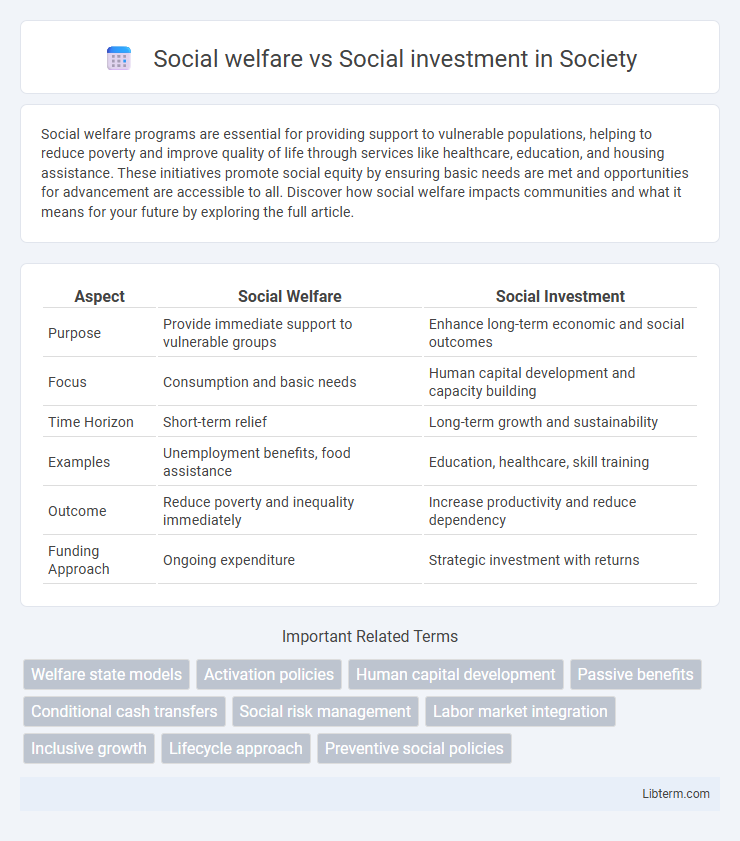Social welfare programs are essential for providing support to vulnerable populations, helping to reduce poverty and improve quality of life through services like healthcare, education, and housing assistance. These initiatives promote social equity by ensuring basic needs are met and opportunities for advancement are accessible to all. Discover how social welfare impacts communities and what it means for your future by exploring the full article.
Table of Comparison
| Aspect | Social Welfare | Social Investment |
|---|---|---|
| Purpose | Provide immediate support to vulnerable groups | Enhance long-term economic and social outcomes |
| Focus | Consumption and basic needs | Human capital development and capacity building |
| Time Horizon | Short-term relief | Long-term growth and sustainability |
| Examples | Unemployment benefits, food assistance | Education, healthcare, skill training |
| Outcome | Reduce poverty and inequality immediately | Increase productivity and reduce dependency |
| Funding Approach | Ongoing expenditure | Strategic investment with returns |
Introduction to Social Welfare and Social Investment
Social welfare primarily aims to provide immediate support and basic needs to vulnerable populations through services like healthcare, housing, and income assistance. Social investment focuses on long-term economic growth by funding education, job training, and preventive health measures that enhance human capital. Both approaches address societal challenges but differ in scope: welfare emphasizes safety nets, while investment targets sustainable development and resilience.
Historical Evolution of Social Welfare Models
Social welfare models have evolved through distinct historical phases, moving from traditional charity-based systems to more structured government-led welfare states emerging in the early 20th century. Social investment models gained prominence in the late 20th century, emphasizing human capital development and long-term economic benefits through education, healthcare, and social services. This shift reflects a broader trend from reactive social protection to proactive social policies aimed at enhancing individual capabilities and promoting sustainable economic growth.
Defining Social Welfare: Principles and Objectives
Social welfare encompasses government programs aimed at providing immediate assistance to improve the living conditions of vulnerable populations through direct support such as healthcare, housing, and income aid. Its principles center on equity, social justice, and ensuring a safety net that addresses urgent needs and reduces poverty and inequality. The primary objective is to enhance social protection and promote well-being by stabilizing individuals and families facing economic or social hardships.
Understanding Social Investment: Concept and Goals
Social investment refers to the strategic allocation of resources to generate long-term social and economic benefits, emphasizing empowerment and sustainable growth. Unlike traditional social welfare, which primarily addresses immediate needs and poverty alleviation, social investment focuses on enhancing human capital through education, healthcare, and active labor market policies. The core goal is to create resilient communities by fostering skills, employment opportunities, and social inclusion that reduce future dependency on welfare systems.
Key Differences Between Social Welfare and Social Investment
Social welfare primarily provides immediate financial aid and basic services to support vulnerable populations, focusing on alleviating poverty and meeting urgent needs. Social investment emphasizes long-term economic growth by funding education, healthcare, and skills development to improve individual productivity and societal well-being. Key differences include the temporal focus--short-term relief versus sustainable growth--and objectives: social welfare targets direct aid, while social investment aims to generate future social and economic returns.
Policy Approaches: Welfare State vs Social Investment State
The Welfare State emphasizes redistributive policies, providing social safety nets such as unemployment benefits, pensions, and healthcare to cushion citizens against economic risks. In contrast, the Social Investment State prioritizes proactive investments in human capital, including education, training, and childcare, aiming to enhance long-term economic participation and productivity. Policy approaches in the Social Investment State focus on fostering skills and employability, while the Welfare State centers on income support and risk protection.
Impacts on Economic Growth and Social Inclusion
Social welfare programs provide immediate financial support and basic services to reduce poverty and inequality, stabilizing consumption and fostering short-term social inclusion. Social investment strategies prioritize education, healthcare, and skill development, enhancing human capital and driving long-term economic growth by increasing workforce productivity. Evidence shows that countries emphasizing social investment experience higher sustainable growth rates and improved social cohesion compared to those relying primarily on traditional social welfare.
Challenges and Criticisms of Social Welfare Systems
Social welfare systems often face challenges related to financial sustainability, inefficiency, and dependency issues, with critics arguing that prolonged reliance on aid can discourage workforce participation and economic self-sufficiency. Administrative complexity and bureaucratic inefficiencies can hinder timely and effective delivery of benefits, leading to unequal access and social exclusion. Balancing immediate social protection with long-term investment in human capital remains a key criticism, as welfare programs may lack incentives for skill development and economic mobility.
Opportunities and Limitations of Social Investment Strategies
Social investment strategies offer opportunities to promote long-term economic growth and social inclusion by funding education, healthcare, and job creation initiatives that empower individuals and communities. However, these strategies face limitations such as the risk of insufficient immediate support for vulnerable populations and the challenge of measuring social returns on investment. Effective implementation requires balancing short-term welfare needs with sustainable social and economic outcomes for inclusive development.
Future Trends and Policy Recommendations
Social welfare systems traditionally emphasize immediate support for vulnerable populations, whereas social investment strategies prioritize education, skills training, and preventive measures to enhance long-term societal productivity. Future trends indicate a growing shift toward integrating digital technologies and data analytics to customize social programs, improving efficiency and outcomes. Policymakers are advised to balance direct welfare provision with proactive investments in human capital and social infrastructure to foster sustainable economic growth and social resilience.
Social welfare Infographic

 libterm.com
libterm.com